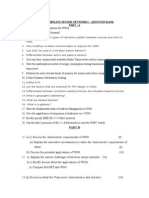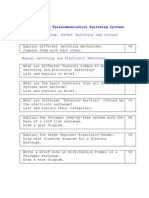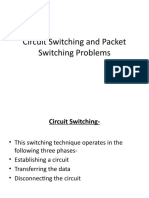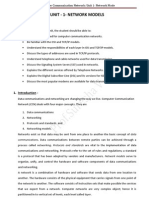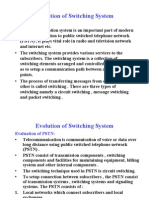0 ratings0% found this document useful (0 votes)
3K viewsStop and Wait Protocol Using NS2
This document describes the "stop-and-wait" protocol for reliable data transfer over unreliable networks. It works by having the sender wait for an acknowledgment of receipt for each packet sent before sending the next packet. If an acknowledgment is not received within a timeout period, the sender will retransmit the unacknowledged packet. This ensures reliable transfer but wastes bandwidth by only allowing one outstanding packet at a time. The document provides code to simulate this protocol using the NS2 network simulator.
Uploaded by
miraclesureshCopyright
© © All Rights Reserved
Available Formats
Download as DOC, PDF, TXT or read online on Scribd
0 ratings0% found this document useful (0 votes)
3K viewsStop and Wait Protocol Using NS2
This document describes the "stop-and-wait" protocol for reliable data transfer over unreliable networks. It works by having the sender wait for an acknowledgment of receipt for each packet sent before sending the next packet. If an acknowledgment is not received within a timeout period, the sender will retransmit the unacknowledged packet. This ensures reliable transfer but wastes bandwidth by only allowing one outstanding packet at a time. The document provides code to simulate this protocol using the NS2 network simulator.
Uploaded by
miraclesureshCopyright
© © All Rights Reserved
Available Formats
Download as DOC, PDF, TXT or read online on Scribd
You are on page 1/ 7
"Stop-and-Wait" protocol using NS2
1. Background
"stop-n-wait" (sometimes known as "positive acknowledgement with
retransmission") is the fundamental technique to provide reliable transfer
under unreliable packet delivery system.
2. How this protocol works..
1) Normal operation
After transmitting one packet, the sender waits
for anacknowledgment (ACK) from the
receiver before transmitting the next one. In
this way, the sender can recognize that the
previous packet is transmitted successfuly and
we could say "stop-n-wait" guarantees reliable
transfer between nodes.
To support this feature, the sender keeps a
record of each packet it sends.
Also, to avoid confusion caused by delayed or
duplicated ACKs, "stop-n-wait" sends each
packets with unique sequence numbers and
receives that numbers in each ACKs.
2) Timeout
If the sender doesn't
receive ACK for
previous sent packet
after a certain period
of time, the
sender times
out and retransmits t
hat packet again.
There are two cases
when the sender
doesn't receive ACK;
One is when the
ACK is lost and the
other is when the
frame itself is not
transmitted.
To support this
feature, the sender
keeps timer per each
packet.
3. How it is shown in nam (network animator)..
"stop-n-wait" protocol can be shown as below in nam.
1. Packet_0 is sent and ACK_0 is received
2. Packet_1 is sent and ACK_1 is received
3. Packet_2 will be sent and be received and so on..
4. Shortcoming
The main shortcoming of the stop-and-wait algorithm is that it allows the
sender to have only one outstanding frame on the link at a time. The sender
should wait till it gets an ACK of previous frame before it sends next frame. As
a result, it wastes a substantial amount of network bandwidth. To improve
efficiency while providing reliability, "sliding window" protocol is appeared.
Stop-n-Wait ns script
# stop and wait protocol in normal situation
# features : labeling, annotation, nam-graph, and window size monitoring
set ns [new Simulator]
set n0 [$ns node]
set n1 [$ns node]
$ns at 0.0 "$n0 label Sender"
$ns at 0.0 "$n1 label Receiver"
set nf [open A1-stop-n-wait.nam w]
$ns namtrace-all $nf
set f [open A1-stop-n-wait.tr w]
$ns trace-all $f
$ns duplex-link $n0 $n1 0.2Mb 200ms DropTail
$ns duplex-link-op $n0 $n1 orient right
$ns queue-limit $n0 $n1 10
Agent/TCP set nam_tracevar_ true
set tcp [new Agent/TCP]
$tcp set window_ 1
$tcp set maxcwnd_ 1
$ns attach-agent $n0 $tcp
set sink [new Agent/TCPSink]
$ns attach-agent $n1 $sink
$ns connect $tcp $sink
set ftp [new Application/FTP]
$ftp attach-agent $tcp
$ns add-agent-trace $tcp tcp
$ns monitor-agent-trace $tcp
$tcp tracevar cwnd_
$ns at 0.1 "$ftp start"
$ns at 3.0 "$ns detach-agent $n0 $tcp ; $ns detach-agent $n1 $sink"
$ns at 3.5 "finish"
$ns at 0.0 "$ns trace-annotate \"Stop and Wait with normal operation\""
$ns at 0.05 "$ns trace-annotate \"FTP starts at 0.1\""
$ns at 0.11 "$ns trace-annotate \"Send Packet_0\""
$ns at 0.35 "$ns trace-annotate \"Receive Ack_0\""
$ns at 0.56 "$ns trace-annotate \"Send Packet_1\""
$ns at 0.79 "$ns trace-annotate \"Receive Ack_1\""
$ns at 0.99 "$ns trace-annotate \"Send Packet_2\""
$ns at 1.23 "$ns trace-annotate \"Receive Ack_2 \""
$ns at 1.43 "$ns trace-annotate \"Send Packet_3\""
$ns at 1.67 "$ns trace-annotate \"Receive Ack_3\""
$ns at 1.88 "$ns trace-annotate \"Send Packet_4\""
$ns at 2.11 "$ns trace-annotate \"Receive Ack_4\""
$ns at 2.32 "$ns trace-annotate \"Send Packet_5\""
$ns at 2.55 "$ns trace-annotate \"Receive Ack_5 \""
$ns at 2.75 "$ns trace-annotate \"Send Packet_6\""
$ns at 2.99 "$ns trace-annotate \"Receive Ack_6\""
$ns at 3.1 "$ns trace-annotate \"FTP stops\""
proc finish {} {
global ns nf
$ns flush-trace
close $nf
puts "filtering..."
exec tclsh ../ns-allinone-2.1b5/nam-1.0a7/bin/namfilter.tcl A1-stop-n-wait.nam
puts "running nam..."
exec nam A1-stop-n-wait.nam &
exit 0
}
$ns run
You might also like
- Unit-V Handoffs, Droped Calls and Cell Splitting: Ece/Liet C410 CMC Notes Sudheer Asst Prof ECE DeptNo ratings yetUnit-V Handoffs, Droped Calls and Cell Splitting: Ece/Liet C410 CMC Notes Sudheer Asst Prof ECE Dept13 pages
- 1 Compare I-TCP, S-TCP and M-TCP 2 Understand CO3: Assignment # 2No ratings yet1 Compare I-TCP, S-TCP and M-TCP 2 Understand CO3: Assignment # 28 pages
- Embedded IoT Assignment Answers TemplateNo ratings yetEmbedded IoT Assignment Answers Template5 pages
- EX - No 8. Simulation of Distance Vector/Link State RoutingNo ratings yetEX - No 8. Simulation of Distance Vector/Link State Routing2 pages
- Cellular and Mobile Communication: Delaying HandoffNo ratings yetCellular and Mobile Communication: Delaying Handoff6 pages
- A REPORT ON MIMO IN WIRELESS APPLICATIONS - FinalNo ratings yetA REPORT ON MIMO IN WIRELESS APPLICATIONS - Final11 pages
- A) Why A Hexagonal Shape Is Preferred Over Triangular or Square Cell Shapes To Represent The Cellular Architecture? JustifyNo ratings yetA) Why A Hexagonal Shape Is Preferred Over Triangular or Square Cell Shapes To Represent The Cellular Architecture? Justify12 pages
- Transport Layer - Mcqs With Answer: C. PacketsNo ratings yetTransport Layer - Mcqs With Answer: C. Packets23 pages
- Programming Techniques for Turing Machine constructionNo ratings yetProgramming Techniques for Turing Machine construction31 pages
- Question Bank - Telecommunication Switching Systems (404187)80% (5)Question Bank - Telecommunication Switching Systems (404187)31 pages
- Timers, Serial Port & Interrupts in 8051No ratings yetTimers, Serial Port & Interrupts in 805151 pages
- CDMA Basics Is-95 Forward & Reverse ChannelNo ratings yetCDMA Basics Is-95 Forward & Reverse Channel41 pages
- Circuit Switching and Packet Switching ProblemsNo ratings yetCircuit Switching and Packet Switching Problems30 pages
- LAB Manual: EC8563 - Communication Networks LaboratoryNo ratings yetLAB Manual: EC8563 - Communication Networks Laboratory48 pages
- DMA Controller and Its Operations - Narendra Kumar100% (1)DMA Controller and Its Operations - Narendra Kumar2 pages
- Chapter 9: Transport Layer and Security Protocols For Ad Hoc Wireless Networks100% (3)Chapter 9: Transport Layer and Security Protocols For Ad Hoc Wireless Networks85 pages
- CCN Notes For Unit 1. VTU Students. Prof - Suresha V85% (13)CCN Notes For Unit 1. VTU Students. Prof - Suresha V38 pages
- Ec3501 Wireless Communication 1560801494 WC Lab ManualNo ratings yetEc3501 Wireless Communication 1560801494 WC Lab Manual24 pages
- Assignment 1 - Solutions: - Compute The Maximum Doppler Frequency F If The Transmitter Is Moving at 72 KMPH0% (1)Assignment 1 - Solutions: - Compute The Maximum Doppler Frequency F If The Transmitter Is Moving at 72 KMPH5 pages
- Advanced Computer Architecture Question PaperNo ratings yetAdvanced Computer Architecture Question Paper1 page
- Chapter 2 Evaluation of Switching System 240810new100% (11)Chapter 2 Evaluation of Switching System 240810new124 pages
- Elective III-410252C-Embedded and Real Time Operating Systems Question Bank100% (1)Elective III-410252C-Embedded and Real Time Operating Systems Question Bank2 pages
- Enhancing CC Environment Using A Cluster As A Service100% (1)Enhancing CC Environment Using A Cluster As A Service40 pages
- Stop and Wait Arq Protocol Simulation: An Assignment Project Report OnNo ratings yetStop and Wait Arq Protocol Simulation: An Assignment Project Report On16 pages
- Aim: To Install and Configure Network Simulator and Learn Basics of TCL ScriptingNo ratings yetAim: To Install and Configure Network Simulator and Learn Basics of TCL Scripting9 pages
- GE6161 Computer Practices Laboratory LTPC 0 0 3 2 List of ExperimentsNo ratings yetGE6161 Computer Practices Laboratory LTPC 0 0 3 2 List of Experiments2 pages
- Velammal College of Engineering & Technology, Madurai - 625 009 Department of Information TechnologyNo ratings yetVelammal College of Engineering & Technology, Madurai - 625 009 Department of Information Technology1 page
- Design and Analysis of Algorithms 2 Marks and 16 MarksNo ratings yetDesign and Analysis of Algorithms 2 Marks and 16 Marks8 pages
- Project Report Preparation Guidelines For PGNo ratings yetProject Report Preparation Guidelines For PG12 pages
- #1 Web Development Course in Delhi NCR - IfDA InstituteNo ratings yet#1 Web Development Course in Delhi NCR - IfDA Institute6 pages
- Information Security: Principles and Practices, 2 EditionNo ratings yetInformation Security: Principles and Practices, 2 Edition37 pages
- Seminar Report On: Wideband Code-Division Multiple Access (Wcdma)No ratings yetSeminar Report On: Wideband Code-Division Multiple Access (Wcdma)21 pages
- Mini Project Report: A Dissertation Submitted in Partial Fulfilment of The Requirements For The Award of Degree ofNo ratings yetMini Project Report: A Dissertation Submitted in Partial Fulfilment of The Requirements For The Award of Degree of38 pages
- Chế Độ Cắt Gia Công Cơ Khí - Nguyễn Ngọc Đào, 256 TrangNo ratings yetChế Độ Cắt Gia Công Cơ Khí - Nguyễn Ngọc Đào, 256 Trang256 pages
- Srimad Bhagavad Gita (Sanskrit, Hindi and English) - Internet ArchiveNo ratings yetSrimad Bhagavad Gita (Sanskrit, Hindi and English) - Internet Archive2 pages
- Rivali Park Moonrise - Upcoming Project in Borivali MumbaiNo ratings yetRivali Park Moonrise - Upcoming Project in Borivali Mumbai7 pages
- Node-B Integration Engineering Handbook521 V4 PDF100% (2)Node-B Integration Engineering Handbook521 V4 PDF926 pages
- Unit-V Handoffs, Droped Calls and Cell Splitting: Ece/Liet C410 CMC Notes Sudheer Asst Prof ECE DeptUnit-V Handoffs, Droped Calls and Cell Splitting: Ece/Liet C410 CMC Notes Sudheer Asst Prof ECE Dept
- 1 Compare I-TCP, S-TCP and M-TCP 2 Understand CO3: Assignment # 21 Compare I-TCP, S-TCP and M-TCP 2 Understand CO3: Assignment # 2
- EX - No 8. Simulation of Distance Vector/Link State RoutingEX - No 8. Simulation of Distance Vector/Link State Routing
- Cellular and Mobile Communication: Delaying HandoffCellular and Mobile Communication: Delaying Handoff
- A) Why A Hexagonal Shape Is Preferred Over Triangular or Square Cell Shapes To Represent The Cellular Architecture? JustifyA) Why A Hexagonal Shape Is Preferred Over Triangular or Square Cell Shapes To Represent The Cellular Architecture? Justify
- Programming Techniques for Turing Machine constructionProgramming Techniques for Turing Machine construction
- Question Bank - Telecommunication Switching Systems (404187)Question Bank - Telecommunication Switching Systems (404187)
- LAB Manual: EC8563 - Communication Networks LaboratoryLAB Manual: EC8563 - Communication Networks Laboratory
- DMA Controller and Its Operations - Narendra KumarDMA Controller and Its Operations - Narendra Kumar
- Chapter 9: Transport Layer and Security Protocols For Ad Hoc Wireless NetworksChapter 9: Transport Layer and Security Protocols For Ad Hoc Wireless Networks
- CCN Notes For Unit 1. VTU Students. Prof - Suresha VCCN Notes For Unit 1. VTU Students. Prof - Suresha V
- Ec3501 Wireless Communication 1560801494 WC Lab ManualEc3501 Wireless Communication 1560801494 WC Lab Manual
- Assignment 1 - Solutions: - Compute The Maximum Doppler Frequency F If The Transmitter Is Moving at 72 KMPHAssignment 1 - Solutions: - Compute The Maximum Doppler Frequency F If The Transmitter Is Moving at 72 KMPH
- Chapter 2 Evaluation of Switching System 240810newChapter 2 Evaluation of Switching System 240810new
- Elective III-410252C-Embedded and Real Time Operating Systems Question BankElective III-410252C-Embedded and Real Time Operating Systems Question Bank
- Enhancing CC Environment Using A Cluster As A ServiceEnhancing CC Environment Using A Cluster As A Service
- Stop and Wait Arq Protocol Simulation: An Assignment Project Report OnStop and Wait Arq Protocol Simulation: An Assignment Project Report On
- Aim: To Install and Configure Network Simulator and Learn Basics of TCL ScriptingAim: To Install and Configure Network Simulator and Learn Basics of TCL Scripting
- GE6161 Computer Practices Laboratory LTPC 0 0 3 2 List of ExperimentsGE6161 Computer Practices Laboratory LTPC 0 0 3 2 List of Experiments
- Velammal College of Engineering & Technology, Madurai - 625 009 Department of Information TechnologyVelammal College of Engineering & Technology, Madurai - 625 009 Department of Information Technology
- Design and Analysis of Algorithms 2 Marks and 16 MarksDesign and Analysis of Algorithms 2 Marks and 16 Marks
- #1 Web Development Course in Delhi NCR - IfDA Institute#1 Web Development Course in Delhi NCR - IfDA Institute
- Information Security: Principles and Practices, 2 EditionInformation Security: Principles and Practices, 2 Edition
- Seminar Report On: Wideband Code-Division Multiple Access (Wcdma)Seminar Report On: Wideband Code-Division Multiple Access (Wcdma)
- Mini Project Report: A Dissertation Submitted in Partial Fulfilment of The Requirements For The Award of Degree ofMini Project Report: A Dissertation Submitted in Partial Fulfilment of The Requirements For The Award of Degree of
- Chế Độ Cắt Gia Công Cơ Khí - Nguyễn Ngọc Đào, 256 TrangChế Độ Cắt Gia Công Cơ Khí - Nguyễn Ngọc Đào, 256 Trang
- Srimad Bhagavad Gita (Sanskrit, Hindi and English) - Internet ArchiveSrimad Bhagavad Gita (Sanskrit, Hindi and English) - Internet Archive
- Rivali Park Moonrise - Upcoming Project in Borivali MumbaiRivali Park Moonrise - Upcoming Project in Borivali Mumbai











